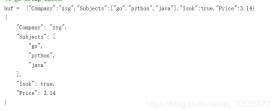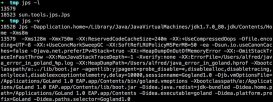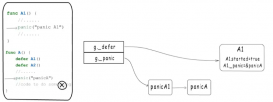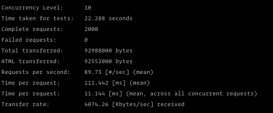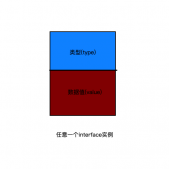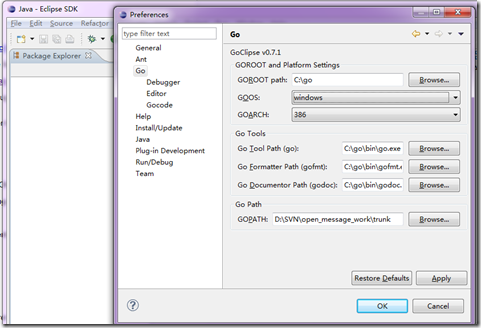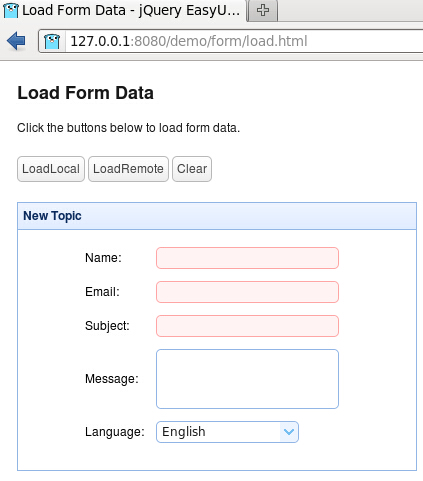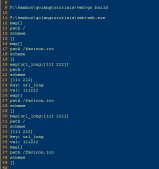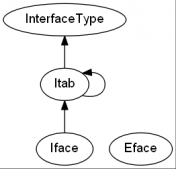核心思想
以空间换时间,访问速度与填充因子有关
扩容hash表的时候每次都增大2倍,hash表大小始终为2的整数倍,有(hash mod 2^B) == (hash & (2^B-1)),方便于简化运算,避免取余操作
扩容前后的 hash mod 容量大小 是不等的,因此要重新计算每一项在hash表中的位置,扩容后需要将old pair重新hash到新的hash表上(就是一个evacuate的过程)。这个过程不是一次性完成的,在每次insert、remove的时候会搬移1-2个pair。就是使用的是增量扩容
每个旧桶的键值对都会分流到2个不同的新桶中
为什么要使用增量扩容?
主要是缩短map容器的响应时间。如果不用增量扩容,当一个map存储很多元素后进行扩容,会阻塞很长时间无法响应请求。增量扩容的本质其实就是将总的扩容时间分摊到了每一次hash操作上
在搬数据的时候,并不会把旧的bucket从oldbucket中删除,只是加上了一个已删除的标记
扩容期间一部分数据在oldbucket中,一部分在bucket中,会对hash表的insert,remove,lookup操作的处理逻辑产生影响,如耗时更长等
只有当oldbucket中所有bucket移动到新表后,才会将oldbucket释放掉
扩容方式
如果grow的太频繁,空间的利用率就会很低,如果很久才grow,会形成很多的overflow buckets,查找速率会下降
map的填充因子是6.5
即当count / 2^B > 6.5时会触发一次grow.翻倍扩容
如果负载因子没有超标,但是使用的溢出桶较多,也会触发扩容。但是是等量扩容
原因是原桶中有太多的键值对被删除,等量扩容可以使得剩余的键值对排列更加紧凑,节省空间

|
1
2
3
4
|
// Maximum average load of a bucket that triggers growth is 6.5.// Represent as loadFactorNum/loadFactorDen, to allow integer math.loadFactorNum = 13loadFactorDen = 2 |
这个6.5来源于作者的一个测试程序,取了一个相对适中的值
|
1
2
3
4
5
6
7
8
9
10
11
12
13
14
15
16
17
18
19
20
21
22
|
// Picking loadFactor: too large and we have lots of overflow// buckets, too small and we waste a lot of space. I wrote// a simple program to check some stats for different loads:// (64-bit, 8 byte keys and elems)// loadFactor %overflow bytes/entry hitprobe missprobe// 4.00 2.13 20.77 3.00 4.00// 4.50 4.05 17.30 3.25 4.50// 5.00 6.85 14.77 3.50 5.00// 5.50 10.55 12.94 3.75 5.50// 6.00 15.27 11.67 4.00 6.00// 6.50 20.90 10.79 4.25 6.50// 7.00 27.14 10.15 4.50 7.00// 7.50 34.03 9.73 4.75 7.50// 8.00 41.10 9.40 5.00 8.00//// %overflow = percentage of buckets which have an overflow bucket// bytes/entry = overhead bytes used per key/elem pair// hitprobe = # of entries to check when looking up a present key// missprobe = # of entries to check when looking up an absent key//// Keep in mind this data is for maximally loaded tables, i.e. just// before the table grows. Typical tables will be somewhat less loaded. |
源码分析
|
1
2
3
4
5
6
7
8
9
10
11
12
13
14
15
16
17
18
19
20
21
22
23
24
25
26
27
28
29
30
31
32
33
34
35
36
37
38
39
40
41
42
43
44
45
46
47
48
49
50
51
52
53
54
55
56
57
58
59
60
61
62
63
64
65
66
67
68
69
70
71
72
73
74
75
76
77
78
79
80
81
82
83
84
85
86
87
88
89
90
91
92
93
94
95
96
97
98
99
100
101
102
103
104
105
106
107
|
// 只是分配新的buckets,并将老的buckets挂到oldbuckets字段上// 真正搬迁的动作在growWork()中func hashGrow(t *maptype, h *hmap) { // If we've hit the load factor, get bigger. // Otherwise, there are too many overflow buckets, // so keep the same number of buckets and "grow" laterally. // B+1 相当于之前的2倍空间 bigger := uint8(1) // 对应条件2 if !overLoadFactor(h.count+1, h.B) { // 进行等量扩容,B不变 bigger = 0 h.flags |= sameSizeGrow } // 将oldbuckets挂到buckets上 oldbuckets := h.buckets // 申请新的buckets空间 newbuckets, nextOverflow := makeBucketArray(t, h.B+bigger, nil) // 对标志位的处理 // &^表示 按位置0 // x=01010011 // y=01010100 // z=x&^y=00000011 // 如果y的bit位为1,那么z相应的bit位就为0 // 否则z对应的bit位就和x对应的bit位相同 // // 其实就是将h.flags的iterator和oldItertor位置为0 // 如果发现iterator位为1,那就把它转接到 oldIterator 位 // 使得 oldIterator 标志位变成 1 // bucket挂到了oldbuckets下,那么标志位也一样转移过去 flags := h.flags &^ (iterator | oldIterator) if h.flags&iterator != 0 { flags |= oldIterator } // // 可能有迭代器使用 buckets // iterator = 1 // 可能有迭代器使用 oldbuckets // oldIterator = 2 // 有协程正在向 map 中写入 key // hashWriting = 4 // 等量扩容(对应条件 2) // sameSizeGrow = 8 // 提交grow的动作 // commit the grow (atomic wrt gc) h.B += bigger h.flags = flags h.oldbuckets = oldbuckets h.buckets = newbuckets // 搬迁进度为0 h.nevacuate = 0 // 溢出bucket数量为0 h.noverflow = 0 if h.extra != nil && h.extra.overflow != nil { // Promote current overflow buckets to the old generation. if h.extra.oldoverflow != nil { throw("oldoverflow is not nil") } h.extra.oldoverflow = h.extra.overflow h.extra.overflow = nil } if nextOverflow != nil { if h.extra == nil { h.extra = new(mapextra) } h.extra.nextOverflow = nextOverflow } // the actual copying of the hash table data is done incrementally // by growWork() and evacuate().}// growWork 真正执行搬迁工作的函数// 调用其的动作在mapssign和mapdelete函数中,也就是插入、修改或删除的时候都会尝试进行搬迁func growWork(t *maptype, h *hmap, bucket uintptr) { // make sure we evacuate the oldbucket corresponding // to the bucket we're about to use // 确保搬迁的老bucket对应的正在使用的新bucket // bucketmask 作用就是将key算出来的hash值与bucketmask相&,得到key应该落入的bucket // 只有hash值低B位决策key落入那个bucket evacuate(t, h, bucket&h.oldbucketmask()) // evacuate one more oldbucket to make progress on growing // 再搬迁一个bucket,加快搬迁进度,这就是说为什么可能每次操作会搬迁1-2个bucket if h.growing() { evacuate(t, h, h.nevacuate) }}// 返回扩容前的bucketmask// // 所谓的bucketmask作用就是将 key 计算出来的哈希值与 bucketmask 相与// 得到的结果就是 key 应该落入的桶// 比如 B = 5,那么 bucketmask 的低 5 位是 11111,其余位是 0// hash 值与其相与的意思是,只有 hash 值的低 5 位决策 key 到底落入哪个 bucket。// oldbucketmask provides a mask that can be applied to calculate n % noldbuckets().func (h *hmap) oldbucketmask() uintptr { return h.noldbuckets() - 1}// 检查oldbuckets是否搬迁完// growing reports whether h is growing. The growth may be to the same size or bigger.func (h *hmap) growing() bool { return h.oldbuckets != nil} |
|
1
2
3
4
5
6
7
8
9
10
11
12
13
14
15
16
17
18
19
20
21
22
23
24
25
26
27
28
29
30
31
32
33
34
35
36
37
38
39
40
41
42
43
44
45
46
47
48
49
50
51
52
53
54
55
56
57
58
59
60
61
62
63
64
65
66
67
68
69
70
71
72
73
74
75
76
77
78
79
80
81
82
83
84
85
86
87
88
89
90
91
92
93
94
95
96
97
98
99
100
101
102
103
104
105
106
107
108
109
110
111
112
113
114
115
116
117
118
119
120
121
122
123
124
125
126
127
128
129
130
131
132
133
134
135
136
137
138
139
140
141
142
143
144
145
146
147
148
149
150
151
152
153
154
155
156
157
158
159
160
161
162
163
164
165
166
167
168
169
170
171
172
173
174
175
176
177
178
179
180
181
182
183
184
185
186
187
188
189
190
191
192
193
194
195
196
197
198
199
200
201
202
203
204
205
206
207
208
209
210
211
212
213
|
// evacDst is an evacuation destination.type evacDst struct { // 标识bucket移动的目标地址 b *bmap // current destination bucket // k-v的索引 i int // key/elem index into b // 指向k k unsafe.Pointer // pointer to current key storage // 指向v e unsafe.Pointer // pointer to current elem storage}// evacuate 核心搬迁函数func evacuate(t *maptype, h *hmap, oldbucket uintptr) { // 定位老的bucket的地址 b := (*bmap)(add(h.oldbuckets, oldbucket*uintptr(t.bucketsize))) // 结果是2^B,进行计算 如 B = 5,结果为32 newbit := h.noldbuckets() // 如果b没被搬迁过 if !evacuated(b) { // TODO: reuse overflow buckets instead of using new ones, if there // is no iterator using the old buckets. (If !oldIterator.) // xy contains the x and y (low and high) evacuation destinations. // xy包含了两个可能搬迁到的目的bucket地址 // 默认是等量扩容的,用x来搬迁 var xy [2]evacDst x := &xy[0] x.b = (*bmap)(add(h.buckets, oldbucket*uintptr(t.bucketsize))) x.k = add(unsafe.Pointer(x.b), dataOffset) x.e = add(x.k, bucketCnt*uintptr(t.keysize)) // 如果不是等量扩容,前后的bucket序号有变 // 使用y来搬迁 if !h.sameSizeGrow() { // Only calculate y pointers if we're growing bigger. // Otherwise GC can see bad pointers. y := &xy[1] // y代表的bucket序号增加了2^B y.b = (*bmap)(add(h.buckets, (oldbucket+newbit)*uintptr(t.bucketsize))) y.k = add(unsafe.Pointer(y.b), dataOffset) y.e = add(y.k, bucketCnt*uintptr(t.keysize)) } // 遍历所有的bucket,包括溢出bucket // b是老bucket的地址 for ; b != nil; b = b.overflow(t) { k := add(unsafe.Pointer(b), dataOffset) e := add(k, bucketCnt*uintptr(t.keysize)) // 遍历bucket里所有的cell for i := 0; i < bucketCnt; i, k, e = i+1, add(k, uintptr(t.keysize)), add(e, uintptr(t.elemsize)) { // 当前cell的tophash值 top := b.tophash[i] // 如果cell为空,即没有key // 说明其被搬迁过,作标记然后继续下一个cell if isEmpty(top) { b.tophash[i] = evacuatedEmpty continue } // 一般不会出现这种情况 // 未搬迁的cell只可能是empty或者正常的tophash // 不会小于minTopHash if top < minTopHash { throw("bad map state") } // 进行一次拷贝避免相同内存地址问题 k2 := k // key如果是指针就进行解引用 if t.indirectkey() { k2 = *((*unsafe.Pointer)(k2)) } // 默认值为0标识默认是使用x,进行等量扩容 var useY uint8 // 增量扩容 if !h.sameSizeGrow() { // Compute hash to make our evacuation decision (whether we need // to send this key/elem to bucket x or bucket y). // 计算hash值,与第一次写入一样 hash := t.hasher(k2, uintptr(h.hash0)) // 有协程在遍历map 且 出现相同的key,计算出的hash值不同 // 这里只会有一种情况,也就是float64的时候 // 每次hash出来都会是不同的hash值,这就意味着无法通过get去获取其key确切位置 // 因此采用取最低位位置来分辨 // 为下一个level重新计算一个随机的tophash // 这些key将会在多次增长后均匀的分布在所有的存储桶中 if h.flags&iterator != 0 && !t.reflexivekey() && !t.key.equal(k2, k2) { // If key != key (NaNs), then the hash could be (and probably // will be) entirely different from the old hash. Moreover, // it isn't reproducible. Reproducibility is required in the // presence of iterators, as our evacuation decision must // match whatever decision the iterator made. // Fortunately, we have the freedom to send these keys either // way. Also, tophash is meaningless for these kinds of keys. // We let the low bit of tophash drive the evacuation decision. // We recompute a new random tophash for the next level so // these keys will get evenly distributed across all buckets // after multiple grows. // 第B位 置1 // 如果tophash最低位是0就分配到x part 否则分配到y part useY = top & 1 top = tophash(hash) } else { // 对于正常的key // 第B位 置0 if hash&newbit != 0 { // 使用y部分 useY = 1 } } } if evacuatedX+1 != evacuatedY || evacuatedX^1 != evacuatedY { throw("bad evacuatedN") } // 这里其实就是重新设置tophash值 // 标记老的cell的tophash值,表示搬到useT部分(可能是x也可能是y,看具体取值) b.tophash[i] = evacuatedX + useY // evacuatedX + 1 == evacuatedY // 选择目标bucket的内存起始部分 dst := &xy[useY] // evacuation destination // 如果i=8说明要溢出了 if dst.i == bucketCnt { // 新建一个溢出bucket dst.b = h.newoverflow(t, dst.b) // 从0开始计数 dst.i = 0 // 标识key要移动到的位置 dst.k = add(unsafe.Pointer(dst.b), dataOffset) // 标识value要移动到的位置 dst.e = add(dst.k, bucketCnt*uintptr(t.keysize)) } // 重新设置tophash dst.b.tophash[dst.i&(bucketCnt-1)] = top // mask dst.i as an optimization, to avoid a bounds check if t.indirectkey() { // 将原key(指针类型)复制到新的位置 *(*unsafe.Pointer)(dst.k) = k2 // copy pointer } else { // 将原key(值类型)复制到新位置 typedmemmove(t.key, dst.k, k) // copy elem } // 如果v是指针,操作同key if t.indirectelem() { *(*unsafe.Pointer)(dst.e) = *(*unsafe.Pointer)(e) } else { typedmemmove(t.elem, dst.e, e) } // 定位到下一个cell dst.i++ // These updates might push these pointers past the end of the // key or elem arrays. That's ok, as we have the overflow pointer // at the end of the bucket to protect against pointing past the // end of the bucket. // 两个溢出指针在bucket末尾用于保证 遍历到bucket末尾的指针 dst.k = add(dst.k, uintptr(t.keysize)) dst.e = add(dst.e, uintptr(t.elemsize)) } } // 如果没有协程在用老的bucket,就将老的bucket清除,帮助gc // Unlink the overflow buckets & clear key/elem to help GC. if h.flags&oldIterator == 0 && t.bucket.ptrdata != 0 { b := add(h.oldbuckets, oldbucket*uintptr(t.bucketsize)) // Preserve b.tophash because the evacuation // state is maintained there. ptr := add(b, dataOffset) n := uintptr(t.bucketsize) - dataOffset // 只清除k-v部分,tophash用于标识搬迁状态 memclrHasPointers(ptr, n) } } // 如果此次搬迁的bucket等于当前搬迁进度,更新搬迁进度 if oldbucket == h.nevacuate { advanceEvacuationMark(h, t, newbit) }}// 更新搬迁进度func advanceEvacuationMark(h *hmap, t *maptype, newbit uintptr) { // 进度+1 h.nevacuate++ // 尝试往后看1024个bucket,确保行为是O(1)的 // Experiments suggest that 1024 is overkill by at least an order of magnitude. // Put it in there as a safeguard anyway, to ensure O(1) behavior. stop := h.nevacuate + 1024 if stop > newbit { stop = newbit } // 寻找没有搬迁过的bucket for h.nevacuate != stop && bucketEvacuated(t, h, h.nevacuate) { h.nevacuate++ } // 现在h.nevacuate之前的bucket都被搬迁完毕了 // 如果所有bucket搬迁完毕 if h.nevacuate == newbit { // newbit == # of oldbuckets // 清除oldbuckets,释放bucket array // Growing is all done. Free old main bucket array. h.oldbuckets = nil // 清除老的溢出bucket // [0]表示当前溢出bucket // [1]表示老的溢出bucket // Can discard old overflow buckets as well. // If they are still referenced by an iterator, // then the iterator holds a pointers to the slice. if h.extra != nil { h.extra.oldoverflow = nil } // 清除正在扩容的标志位 h.flags &^= sameSizeGrow }} |
源码里提到 X, Y part,其实就是我们说的如果是扩容到原来的 2 倍,桶的数量是原来的 2 倍,前一半桶被称为 X part,后一半桶被称为 Y part。一个 bucket 中的 key 会分裂落到 2 个桶中。一个位于 X part,一个位于 Y part。所以在搬迁一个 cell 之前,需要知道这个 cell 中的 key 是落到哪个 Part。
其实很简单,重新计算 cell 中 key 的 hash,并向前“多看”一位,决定落入哪个 Part
设置 key 在原始 buckets 的 tophash 为 evacuatedX 或是 evacuatedY,表示已经搬迁到了新 map 的 x part 或是 y part。新 map 的 tophash 则正常取 key 哈希值的高 8 位。
对于增量扩容来说:某个 key 在搬迁前后 bucket 序号可能和原来相等,也可能是相比原来加上 2^B(原来的 B 值),取决于 hash 值 第 6 bit 位是 0 还是 1。
当搬迁碰到 math.NaN() 的 key 时,只通过 tophash 的最低位决定分配到 X part 还是 Y part(如果扩容后是原来 buckets 数量的 2 倍)。如果 tophash 的最低位是 0 ,分配到 X part;如果是 1 ,则分配到 Y part,已搬迁完的key的tophash值是一个状态值,表示key的搬迁去向
到此这篇关于深入了解Golang的map增量扩容的文章就介绍到这了,更多相关 Go增量扩容内容请搜索服务器之家以前的文章或继续浏览下面的相关文章希望大家以后多多支持服务器之家!
原文链接:https://juejin.cn/post/7101685421846822949


